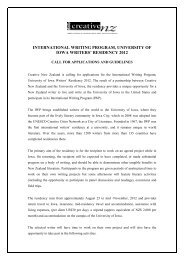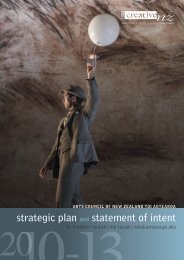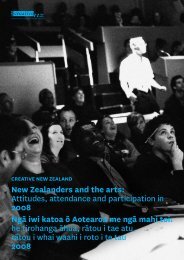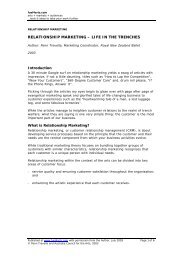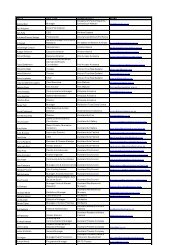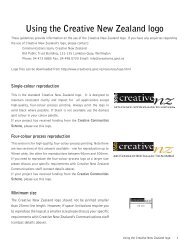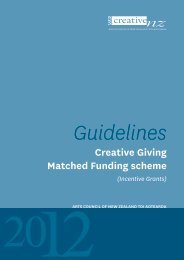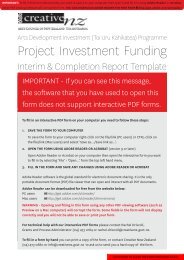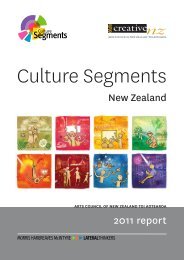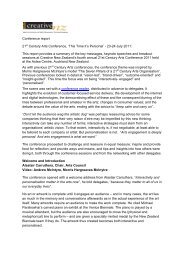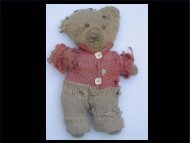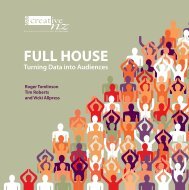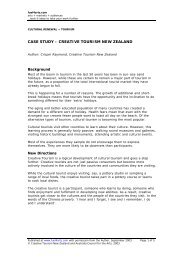Smart Arts - Creative New Zealand
Smart Arts - Creative New Zealand
Smart Arts - Creative New Zealand
- No tags were found...
You also want an ePaper? Increase the reach of your titles
YUMPU automatically turns print PDFs into web optimized ePapers that Google loves.
WHAT’SNEWVisit the What’s newsection of <strong>Creative</strong> <strong>New</strong><strong>Zealand</strong>’s website(www.creativenz.govt.nz) forup-to-date stories about<strong>New</strong> <strong>Zealand</strong> arts andartists.You can send yourrelease or story to its editor(ionam@creativenz.govt.nz),who will assess its newsvalue, edit the release andpost it on the site forapproximately two weeks.Below is an example of astory (the first twoparagraphs and the lastparagraph) posted on theWhat’s new section. It tellsthe reader the importantinformation about what,who, where and when, plusbooking details.Britain’s Sarah Dunant joinsAuckland Writers andReaders FestivalThe 2003 Auckland Writersand Readers Festival, runningfrom 15 – 18 May, isdelighted to announce theaddition of British novelist,broadcaster and critic SarahDunant to its line-up ofinternational writers.To be held at the HyattRegency, the festival hasmore than 45 eventsfeaturing 16 internationalauthors and more than 80<strong>New</strong> <strong>Zealand</strong> participants …Bookings are throughTicketek. For the mostupdated information, checkthe festival website atwww.writersfestival.co.nz.<strong>Smart</strong> arts | Toi huatau52• identify the various media angles and the most appropriate journalist to receive yourrelease: e.g. the arts editor, the chief reporter, the fashion editor, the business reporter• setting out a timeline and a list of the media outlets you intend to approach and when.Magazines, for example, have a three-month to six-week lead time. <strong>New</strong>spapers should becontacted at least two to three weeks in advance for a feature although they can turn a newsstory around in a day. Television and radio deadlines vary. A daily or weekly arts newsprogramme will work two or three weeks ahead when planning content, but may be able torespond to breaking stories as little as a day ahead. Documentary arts series work manymonths in advance so it is advisable to contact the appropriate television productioncompanies to establish deadlines as soon as you know what events you’ll be promoting. 5 The media releaseWriting the releaseA bookseller waits forthe crowds to arriveafter a session at the2003 AucklandWriters and ReadersFestival Gil HanlyIt’s important to write an effective media release to encourage journalists to cover yourshow. A company brainstorming session may spark valuable ideas.A media release should work like a newspaper story: i.e. as you go down the page fewerpeople will read it. Ensure the headline catches attention, the first paragraph contains allthe vital information, and only then go into more detail. A second page may includebiographies of those involved.The length of your release also depends on where you are sending it: 1–2 pages for anews reporter; 1-3 pages for a feature journalist, depending on the complexity andnumber of angles; a couple of paragraphs for the website; 2-3 sentences for a what’s onguide; and one sentence for reading as a sound bite on radio.



